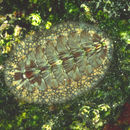Comprehensive Description
provided by Invertebrates of the Salish Sea
This chiton has a hairy girdle all around. The girdle is about the same width all around, and all plates are about the same width. The girdle hairs are not as long as the girdle is wide. The lateral areas of plates 2-7 are separated from the middle region by a ridge or series of small tubercles. The surface of the plates have longitudinal rows of small pits visible with low magnification, especially in the central areas. Plates have streaks and lines of brown, purple-brown, mahogany, or occasionally white. Girdle is cream, brown, or purple-brown above and orange below.
- license
- cc-by-nc-sa
- copyright
- Rosario Beach Marine Laboratory
Look Alikes
provided by Invertebrates of the Salish Sea
How to Distinguish from Similar Species: The hairs are flexible, not stiff and thick as in Mopalia muscosa. Other Mopalias have longer hairs or have tubercles instead of pits on the plates.
- license
- cc-by-nc-sa
- copyright
- Rosario Beach Marine Laboratory
Habitat
provided by Invertebrates of the Salish Sea
Sides or bottoms of large boulders on open coast
- license
- cc-by-nc-sa
- copyright
- Rosario Beach Marine Laboratory
Distribution
provided by Invertebrates of the Salish Sea
Geographical Range: _Prince William Sound, Alaska to Point Conception, CA
- license
- cc-by-nc-sa
- copyright
- Rosario Beach Marine Laboratory
Habitat
provided by Invertebrates of the Salish Sea
Depth Range: Middle and low intertidal
- license
- cc-by-nc-sa
- copyright
- Rosario Beach Marine Laboratory
Comprehensive Description
provided by Invertebrates of the Salish Sea
Biology/Natural History: This species is usually under rocks, and begins crawling when the rock is turned over. They are the fastest crawling chiton I have seen Feeds on many types of algae, especially diatoms and Ulva. Sense light with aesthetes in plates.
- license
- cc-by-nc-sa
- copyright
- Rosario Beach Marine Laboratory

